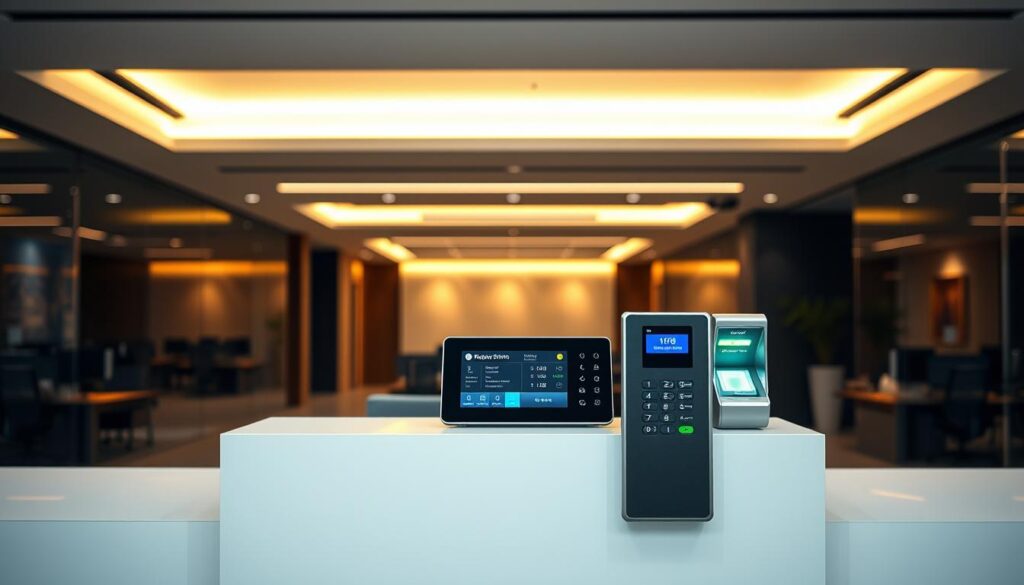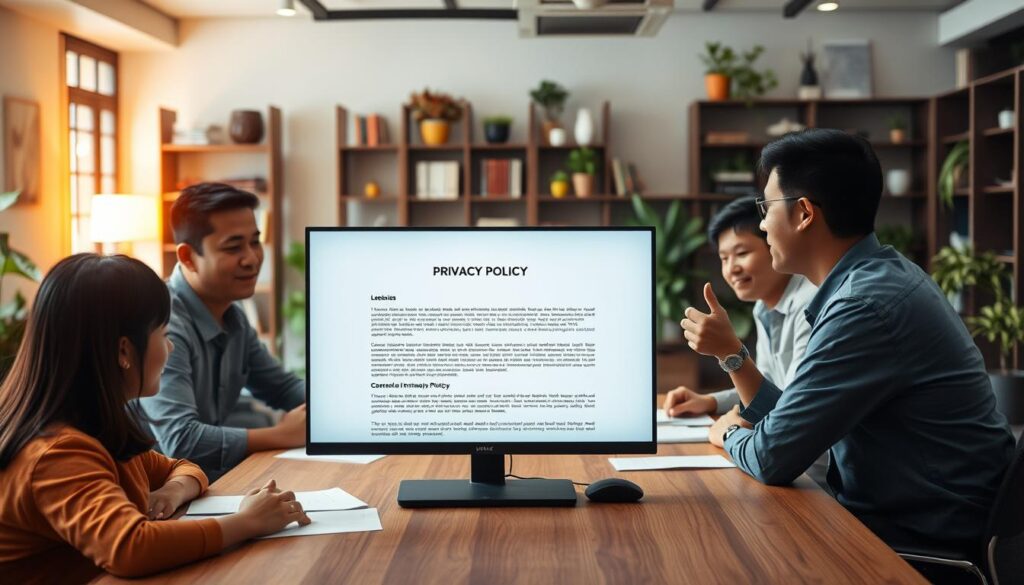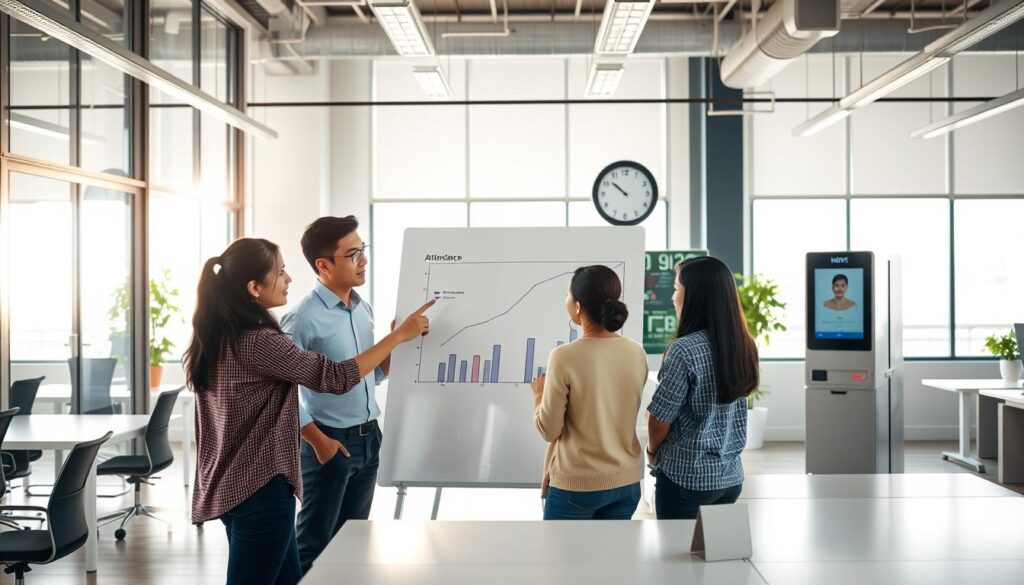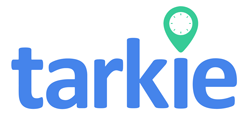In today’s world, technology makes workplaces more efficient. But, are employee privacy rights being ignored for the sake of productivity? Companies are using advanced systems like biometric attendance to track employee time and work. These systems help streamline work but also raise big privacy concerns.
With over 3.1 million companies in Nigeria alone, handling employee data is a big task. It’s important to find a balance between keeping an eye on work and respecting privacy. This section will look at the best ways to protect employee privacy while keeping work running smoothly.
Key Takeaways
- Implementing strong encryption techniques can significantly enhance data protection.
- Data minimization policies can reduce the amount of personal data collected.
- Employee rights should align with modern privacy regulations to prevent legal repercussions.
- Transparent communication about data practices fosters trust among employees.
- Regular audits can help ensure data security compliance and continuous improvement.
Understanding Employee Privacy in the Digital Age
Technology is changing the workplace fast. Knowing about employee privacy is key. It’s about keeping personal info, like biometric data and work habits, private. With attendance systems, this issue gets even more pressing.
Recent stats show 80% of workers worry about being watched at work. About 60% don’t know how much their bosses are monitoring them. This lack of knowledge can lead to distrust.
Also, 70% of employees want to know about monitoring. Following data protection laws is crucial. Employers must protect employee data to avoid big fines.
Respecting privacy can boost employee retention by 25%. Clear privacy policies can make workers 30% happier. Protecting emails and other personal communications boosts engagement. In short, respecting privacy is good for everyone in the workplace.
What are Attendance Systems?
Attendance systems are key in today’s workplaces. They automate tracking of employee hours and attendance. These time-tracking tools make work more efficient and accurate. They are vital for any business that needs to manage attendance well.
Biometric attendance solutions are popular because they solve problems like buddy punching. They boost attendance accuracy up to 99%.
In the Philippines, small and medium-sized businesses are using these systems more. They help follow labor laws, make operations smoother, and improve payroll accuracy. Automated systems cut down on errors in tracking attendance, keeping records accurate over time.
These systems use advanced tech to collect real-time data on who’s in and who’s not. This boosts accountability and can make employees more engaged and productive. Some systems even have GPS and facial recognition for remote workers.
Also, linking attendance systems with HR tools makes things easier and more efficient. Moving to automated attendance saves HR time and cuts down on costs. It helps them focus on important tasks and reduces the need for paper records and corrections.
The Importance of Data Protection in Attendance Systems
Data protection is key for managing employee info in attendance systems. It’s vital for all businesses to follow privacy rules. Small companies are also at risk, with 46% of cyberattacks hitting those with fewer than 1,000 employees.
Biometric data is a big worry in attendance systems. Once it’s stolen, it can’t be changed like passwords. A ransomware attack can cost a company about 106 million pesos, making strong defenses crucial.
Following the law is also important for protecting employee data. In the U.S., all states have laws about telling people if their data is stolen. Laws like GDPR and CCPA set strict rules for handling employee data. Breaking these can lead to big fines, up to 4% of a company’s global income.
Training employees on data protection is also key. Over 90% of data breaches are due to human mistakes. Teaching employees to be careful with personal data helps keep it safe and follows the law.
| Regulation | Focus | Penalty for Non-Compliance |
|---|---|---|
| GDPR | Employee data management | Up to 4% of global turnover or €20 million |
| CCPA | Consumer rights and data protection | Up to 430,000 pesos for intentional violations. |
| HIPAA | Health information privacy | Varies based on violation level |
| FCRA | Background check regulations | Legal actions and penalties |
Types of Attendance Systems and Their Impact on Employee Privacy
It’s important to know about the different attendance systems and how they affect privacy. Companies are looking for ways to track attendance efficiently. They have to choose between biometric systems and traditional time clocks.
Each option has its own benefits and privacy concerns. Employers need to understand these to make the right choice.
Biometric Attendance Systems
Biometric systems use unique physical traits like fingerprints or facial recognition for tracking. They are very accurate, making attendance management more efficient. Companies see a 30% increase in tracking and payroll processing.
These systems also cut down on time theft by up to 50%. They stop issues like buddy punching.
But, biometric systems raise privacy concerns. They handle sensitive data that needs strong encryption and careful handling. Employees might worry about their biometric data being collected.
It’s crucial to tell employees how their data will be used and protected.
Traditional Time Clocks
Traditional time clocks are simpler than biometric systems for tracking employees. They collect data on when employees come and go. This data helps monitor performance and improve workflows.
Even though they’re less intrusive, companies must follow privacy laws. They need to tell employees how their data is used.
It’s all about finding a balance between privacy and efficiency. Being open about data use builds trust and ensures legal compliance. This is important in places like California and New York.

Best Practices for Protecting Employee Privacy in Attendance Systems
Protecting employee privacy in attendance systems is key for today’s organizations. By using advanced security and following privacy rules, companies can keep sensitive employee info safe.
Implement Strong Encryption Techniques
Companies should use strong encryption like AES-256 for biometric data in attendance systems. Biometric data is very sensitive because it’s unique to each person. When encrypted right, it’s safe from unauthorized access, lowering data breach risks.
Role-based access control (RBAC) helps by only letting authorized people see biometric data. Regular security checks are also important. They help find and fix vulnerabilities, keeping privacy rules followed.
Establish Data Minimization Policies
Data minimization is crucial. It means collecting only what’s needed for specific tasks. For attendance systems, this means collecting only the most important biometric data.
Having clear policies on how long biometric data is kept is also important. This balances business needs with legal rules. These steps not only follow privacy laws but also build trust with employees.
Employee Rights and Privacy Regulations
Employees have key rights to their personal data. These rights make sure they know about the data collected, how it’s used, and how it’s protected. Laws like the Data Privacy Act in the Philippines help companies follow these rights. Transparency in monitoring builds trust in the workplace and should be clearly stated in privacy policies.
Many laws protect employee rights. The Electronic Communications Privacy Act, for example, keeps emails and communications private in the U.S. Companies need to know these laws, including the General Data Protection Regulation (GDPR). GDPR makes sure employees know about data collection, helping protect their rights.
Article 88 of the GDPR talks about clear data rules in work settings. It makes sure employees can correct or delete their data. In many places, employers need consent to monitor employees. Using unauthorized software can break privacy laws, showing why following the law is key.
Companies that focus on employee rights and privacy do better. They see better job satisfaction and performance. HR teams need to keep up with changing laws through training and checks.

Following privacy laws helps companies a lot. Companies that follow GDPR and the Data Privacy Act see better morale and success. For more on tracking employees while respecting privacy, check out this guide.
Employee Privacy, Attendance Systems, Data Protection
Understanding employee privacy with attendance systems is key. It involves knowing how to protect sensitive information and follow rules. Companies must know what personal data is and how to keep it safe. This helps them meet legal standards and keep their employees’ trust.
Identifying Sensitive Information
What counts as sensitive data can change based on where you are. It might include social security numbers, health records, and biometric data. By monitoring employees well, companies can follow the law and earn their team’s trust. It’s crucial to know what data needs protection to create a safe work place.
Understanding Compliance Requirements
Companies using attendance systems face many rules to follow. The General Data Protection Regulation (GDPR) can fine companies up to €20 million or 4% of their global income. In the Philippines, the Data Privacy Act is in place to ensure data is handled properly and with transparency. Knowing these rules helps protect employee data and avoid legal trouble.
| Regulation | Key Points | Penalties for Non-Compliance |
|---|---|---|
| GDPR | Imposes strict data protection measures and requires data minimization | Up to €20 million or 4% of global turnover |
| CCPA | Employees must be notified about data collected | Up to 430,000 pesos for intentional violations. |
| FCRA | Mandates destruction of background check data when no longer needed | Varies by violation severity |
| HIPAA | Protects employee health information requiring consent for access | Financial penalties and further legal actions |
Transparent Communication and Employee Consent
It’s key to talk openly about data use to build trust with employees. Companies need to make clear privacy policies. These should explain how they collect, use, and protect employee data. It’s important to keep these policies up-to-date with new privacy laws.
Creating Clear Privacy Policies
Clear privacy policies mean explaining how data is collected and used. This makes employees feel more secure. Keeping these policies current shows a commitment to protecting data.
Obtaining Explicit Consent for Data Collection
Getting clear consent from employees is crucial before collecting biometric data. This consent should tell employees how their data will be used and protected. A clear consent process builds trust and helps follow privacy laws.

Security Measures for Attendance Systems
Keeping attendance systems secure is key for any organization. It’s important to have strong access control and user authentication. This protects sensitive data and makes sure only the right people can see it. With more data breaches happening, keeping data safe is a top priority.
Access Control and User Authentication
Access control systems set rules for who can see or manage attendance data. This keeps information safe. Role-based access control (RBAC) is a good way to give users the right to access based on their job. It helps prevent unauthorized access and data breaches.
User authentication is also vital for data security. Using secure methods like multi-factor authentication helps protect against unauthorized access. It’s clear that 68% of organizations use multi-factor authentication, showing its importance.
Here’s a breakdown of the security measures organizations can implement to protect their attendance systems:
| Security Measure | Description | Impact on Data Security |
|---|---|---|
| Access Control | Restricts data access to authorized personnel only. | Prevents unauthorized access, reducing the risk of breaches. |
| User Authentication | Verifies the identity of a user before granting access. | Reduces the likelihood of unauthorized user access. |
| Encryption | Protects data both in transit and at rest. | Ensures data cannot be easily intercepted and accessed. |
| Regular Audits | Regular verification of attendance data and system integrity. | Identifies vulnerabilities and ensures compliance. |
Ignoring data security can cost a lot, with breaches costing about 221 million pesos on average. Without strong access controls, 67% of organizations face data breaches. This shows why it’s crucial to be proactive in protecting employee data.
Regular Audits and Continuous Improvement
Regular audits are key to making sure attendance systems follow data protection rules like GDPR and CCPA. These regular audits spot weaknesses, making systems better at fighting off data breaches. By always looking to improve, companies can check their data use regularly. This makes their data handling better and their operations more efficient.
When companies regularly check their employee monitoring during audits, they find and fix data mistakes. This makes their data better and builds trust with customers. It also helps them keep up with changing rules more easily.
Regular audits help companies spot risks, like when they handle sensitive data. Being open about how they handle data can make them stand out. Younger people want to buy from brands that respect their privacy, so following data privacy rules is good for business.

Using what they learn from audits, companies can make their security better. This helps them avoid big fines for not following rules. Keeping an eye on attendance systems helps reduce no-shows and keeps everyone working well together.
| Benefits of Regular Audits | Impact on Continuous Improvement |
|---|---|
| Identifies vulnerabilities in data handling | Enhances overall operational efficiency |
| Improves data accuracy | Fosters a culture of engagement among employees |
| Boosts customer trust | Strengthens compliance with regulations |
| Enhances brand image | Encourages proactive risk management |
Conclusion
Keeping employee privacy safe in attendance systems is key to building trust and openness at work. In the Philippines, following the best data protection practices helps companies meet legal standards. It also makes the workplace better for everyone. This includes using strong encryption, limiting data collection, and being clear about how data is used.
Putting employee privacy first can really help a company do well. For example, dealing with time theft and absences can save a lot of money. In the U.S., time theft costs about 632 billion pesos, and absences cost around 2.1 billion pesos each year. By focusing on protecting data and privacy, businesses can avoid these big losses and keep things running smoothly.
As companies deal with new attendance systems and monitoring, they must protect employee rights. Following the best practices and sticking to data protection laws helps keep information safe. It also makes sure employees feel important and respected. This way, companies can grow and succeed in the long run.
